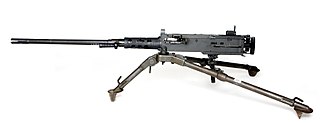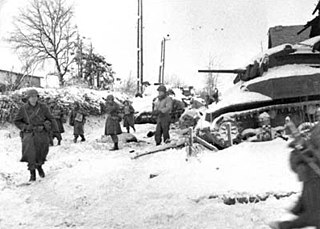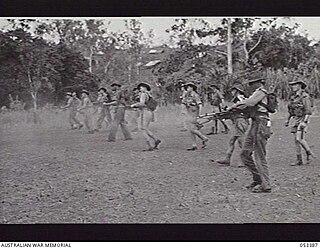Related Research Articles

An ambush is a surprise attack by people lying in wait in a concealed position. Ambushes have been used consistently throughout history, from ancient to modern warfare. In the 20th century, an ambush might involve thousands of soldiers on a large scale, such as over a choke point such as a mountain pass, or a small irregulars band or insurgent group attacking a regular armed force patrols. Theoretically, a single well-armed and concealed soldier could ambush other troops in a surprise attack. Sometimes an ambush can involve the exclusive or combined use of improvised explosive devices, that allow the attackers to hit enemy convoys or patrols while minimizing the risk of being exposed to return fire.

The M2 machine gun or Browning .50 caliber machine gun is a heavy machine gun that was designed near the end of World War I by John Browning. While similar to Browning's earlier M1919 Browning machine gun, which was chambered for the .30-06 cartridge, the M2 uses Browning's larger and more powerful .50 BMG cartridge. The design has had many designations; the official U.S. military designation for the current infantry type is Browning Machine Gun, Cal. .50, M2, HB, Flexible. It is effective against infantry, unarmored or lightly armored vehicles and boats, light fortifications, and low-flying aircraft.

The 14th Armored Division was an armored division of the United States Army assigned to the Seventh Army of the Sixth Army Group during World War II. It remains on the permanent roll of the Regular Army as an inactive division, and is eligible for reactivation. The division is officially nicknamed the "Liberators".

Enfilade and defilade are concepts in military tactics used to describe a military formation's exposure to enemy fire. A formation or position is "in enfilade" if weapon fire can be directed along its longest axis. A unit or position is "in defilade" if it uses natural or artificial obstacles to shield or conceal itself from enfilade and hostile fire. The strategies, named by the English during the Hundred Years' War, use the French enfiler and défiler spoken by English nobility of the time.

In military science, suppressive fire is "fire that degrades the performance of an enemy force below the level needed to fulfill its mission". When used to protect exposed friendly troops advancing on the battlefield, it is commonly called covering fire. Suppression is usually only effective for the duration of the fire. It is one of three types of fire support, which is defined by NATO as "the application of fire, coordinated with the maneuver of forces, to destroy, neutralise or suppress the enemy".

The Battle of Ia Drang was the first major battle between the United States Army and the People's Army of Vietnam (PAVN), as part of the Pleiku Campaign conducted early in the Vietnam War, at the eastern foot of the Chu Pong Massif in the central highlands of Vietnam, in 1965. It is notable for being the first large scale helicopter air assault and also the first use of Boeing B-52 Stratofortress strategic bombers in a tactical support role. Ia Drang set the blueprint for the Vietnam War with the Americans relying on air mobility, artillery fire and close air support, while the PAVN neutralized that firepower by quickly engaging American forces at very close range.

A tactical withdrawal or retreating defensive action is a type of military operation, generally meaning that retreating forces draw back while maintaining contact with the enemy. A withdrawal may be undertaken as part of a general retreat, to consolidate forces, to occupy ground that is more easily defended, force the enemy to overextend to secure a decisive victory, or to lead the enemy into an ambush. It is considered a relatively risky operation, requiring discipline to keep from turning into a disorganized rout or at the very least doing severe damage to the military's morale.

Insurgency weapons and tactics are weapons and tactics, most often involving firearms or explosive devices, intended for use by insurgents to engage in guerrilla warfare against an occupier, or for use by rebels against an established government. One type of insurgency weapon are "homemade" firearms made by non-professionals, such as the Błyskawica (Lightning) submachine gun produced in underground workshops by the Polish resistance movement. Another weapon that is part of the conventional military arsenal, but which has been taken up to great effect by insurgents, is the RPG. Two examples of an improvised weapon used by insurgents would be the improvised explosive devices used in Iraq and the Molotov cocktails used against vehicles and tanks. Two tactics used by many insurgents are assassinations and suicide bomb attacks. The latter tactic is used when an insurgent has a bomb strapped to them or in their car, which provides a low-tech way for insurgents to get explosives close to critical enemy targets.

The Battle of Norfolk was a tank battle fought on February 27, 1991, during the Persian Gulf War, between armored forces of the United States and United Kingdom, and those of the Iraqi Republican Guard in the Muthanna Province of southern Iraq. The primary participants were the U.S. 2nd Armored Division (Forward), 1st Infantry Division (Mechanized), and the Iraqi 18th Mechanized and 9th Armoured Brigades of the Republican Guard Tawakalna Mechanized Infantry Division along with elements from eleven other Iraqi divisions. The 2nd Armored Division(Fwd) was assigned to the American 1st Infantry Division as its 3rd maneuver brigade due to the fact that one of its brigades was not deployed. The 2nd Armored Division(Fwd)'s Task Force 1-41 Infantry would be the spearhead of VII Corps. The British 1st Armoured division was responsible for protecting the right flank of VII Corps, their main adversary being the Iraqi 52nd Armored Division and multiple infantry divisions. It was the final battle of the war before the unilateral ceasefire took effect.

Infantry tactics are the combination of military concepts and methods used by infantry to achieve tactical objectives during combat. The role of the infantry on the battlefield is, typically, to close with and engage the enemy, and hold territorial objectives; infantry tactics are the means by which this is achieved. Infantry commonly makes up the largest proportion of an army's fighting strength, and consequently often suffers the heaviest casualties. Throughout history, infantrymen have sought to minimise their losses in both attack and defence through effective tactics.

The 3rd Reconnaissance Battalion conducts amphibious and ground reconnaissance in support of the 3rd Marine Division and Marine Forces Pacific (MarForPac), operating in the commander's areas of influence. The Battalion is based out of Camp Schwab, a satellite base of Marine Corps Base Camp Smedley D. Butler. It is geographically located on the Okinawa Prefecture in Japan.

The tank destroyer battalion was a type of military unit used by the United States Army during World War II. The unit was organized in one of two different forms—a towed battalion equipped with anti-tank guns, or a mechanized battalion equipped with armored self-propelled guns. The tank destroyer units were formed in response to the German use of massed formations of armored vehicles units early in WWII. The tank destroyer concept envisioned the battalions acting as independent units that would respond at high speed to large enemy tank attacks. In this role, they would be attached in groups or brigades to corps or armies. In practice, they were usually individually attached to infantry divisions. Over one hundred battalions were formed, of which more than half saw combat service. The force was disbanded shortly after the end of the war when the concept had been shown to be militarily unsound.

The 13th Cavalry Regiment is a unit of the United States Army. The 2nd Squadron is currently stationed at Fort Bliss, Texas, as part of the 3rd Armored Brigade Combat Team, 1st Armored Division.

VC and PAVN battle tactics comprised a flexible mix of guerrilla and conventional warfare battle tactics used by Viet Cong (VC) and the North Vietnamese People's Army of Vietnam (PAVN) to defeat their U.S. and South Vietnamese (GVN/ARVN) opponents during the Vietnam War.

The Battle of Lanzerath Ridge was fought on December 16, 1944, the first day of the Battle of the Bulge during World War II, near the village of Lanzerath, Belgium, along the key route for the German advance on the northern shoulder of the operation. The American force consisted of two squads totalling 18 men belonging to a reconnaissance platoon and four forward artillery observers, against a German battalion of about 500 paratroopers. During a day-long confrontation, the American defenders inflicted dozens of casualties on the Germans and delayed by almost 20 hours the advance of the entire 1st SS Panzer Division, the spearhead of the German 6th Panzer Army.

The Battle of Le Mesnil-Patry during the Second World War, was the last attack by an armoured battle group conducted by Canadian troops in Normandy in June 1944. The Queen's Own Rifles of Canada of the 8th Canadian Infantry Brigade of the 3rd Canadian Division, supported by the 6th Armoured Regiment of the 2nd Canadian Armoured Brigade attacked the village of Le Mesnil-Patry in Normandy, to advance southwards towards the higher ground of Hill 107 to the west of Cheux. The attack was intended to support a larger operation by the 50th (Northumbrian) Infantry Division and the 7th Armoured Division to capture the city of Caen and to advance in the centre of the bridgehead next to the First US Army. The battle was a German defensive success but the greater German objective of defeating the invasion by a counter-offensive also failed.

The 1st Squadron, 91st Cavalry Regiment (Airborne) is a light Airborne Reconnaissance Squadron currently serving as the 173rd Airborne Brigade's Reconnaissance, Surveillance and Targeting Acquisition (RSTA) Squadron based out of Tower Barracks in Grafenwöhr, Germany. It is the only Airborne RSTA Squadron within the European, Middle East, and Africa (EMEA) area of responsibility.

Marching fire, also known as walking fire, is a military tactic—a form of suppressive fire used during an infantry assault or combined arms assault. Advancing units fire their weapons without stopping to aim, in an attempt to pin down enemy defenders. Marching fire usually ends with an infantry charge to engage the enemy in close combat. The tactic requires ample ammunition and rapid-fire weapons. It differs from fire and movement in that the attacking force advances in unison rather than leapfrogging forward in alternating groups.
References
- ↑ "Recon By Fire". OPFOR. July 2, 2007. Retrieved 2008-03-24.
- ↑ Jarymowycz, Roman J., Tank tactics: from Normandy to Lorraine, Boulder, CO: Lynne Rienner Publishers, ISBN 1-55587-950-0 (2001), p. 212: The .50 cal. M2HB fitted to tanks and M3 half-tracks was frequently employed against German rearguard forces including snipers and anti-tank teams, often firing into locations merely suspected of hiding such forces[ clarification needed ]
- ↑ Abramski, Anthony V. (Pfc.), Eyewitness Account of Pfc. Anthony V. Abramski, Citation In Support Of Congressional Medal of Honor Award to 2nd Lt. Audie Murphy at Holtzwihr, France, 26 January 1945
- ↑ Jarymowycz, Roman J., Tank Tactics, p. 212
- ↑ Galloway, Joseph L. (1990). "The word was the Ia Drang would be a walk. The word was wrong." U.S. News